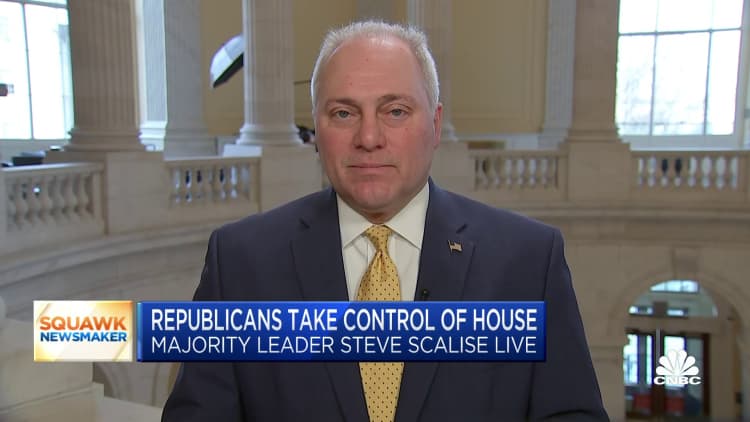House Republican Majority Leader Steve Scalise sidestepped thorny questions Tuesday on whether Congress would allow the U.S. to default on its debt after lawmakers adopted new rules making it more difficult to raise federal limits.
The U.S. is perilously close to hitting its debt ceiling of about $31.4 trillion, the legal limit set by Congress of how much the federal government can borrow. It includes the total amount of federal debt outstanding, about $24.5 trillion, as well as the nearly $6.9 trillion the government has borrowed from itself. If Congress doesn't soon raise the debt ceiling, it would inevitably trigger a default on U.S. Treasury bonds — an unprecedented event that would plunge the nation into financial crisis.
"America over time occasionally hits the debt ceiling because it's like a credit card limit," Scalise, R-La., said at a press conference in the Capitol building. He was responding to a reporter who asked him to outline what lawmakers agreed to on the debt ceiling and whether he could "guarantee" the U.S. wouldn't default.
"And if you're going to ask for an increase in the limit, at some point in time, you've got to sit down and say why are we hitting the limit? Why are we maxing out the credit card? Because this is the nation's credit card," he added.

It will be much more difficult for lawmakers to raise the debt limit under the new Congress since House Speaker Kevin McCarthy, R-Calif., agreed to a rules package that requires any increases in the debt limit to be paired with spending cuts. It was one of several concessions he made to win support from a group of conservative Republicans that had been blocking his speakership.
The debt ceiling debate is already raising questions on Wall Street. Citing McCarthy's hard-fought battle and 15 rounds of voting, Goldman Sachs economists cited the rules changes as cause for concern on whether Congress would lift the debt ceiling, saying in a research note Monday that it would likely be a "close call."
"The debt limit is going to be a problem," the report read. "Fiscal deadlines will pose a greater risk this year than they have for a decade."
The U.S. last raised the debt ceiling in December 2021, by $2.5 trillion. The increase is expected to last until at least July 2023, according to the watchdog group the Committee for a Responsible Federal Budget.
Lifting the debt limit does not authorize any new spending; it allows the government to borrow more money to cover existing commitments. And since the federal government consistently spends more than it takes in in tax revenue, lawmakers have to periodically raise the debt ceiling. Failing to lift the debt ceiling could lead to a government default on its debt and halt daily operations, causing potential turmoil to markets and the economy.
The last major rift over the debt ceiling was in late 2011, driven by holdout from a newly elected Republican congressional majority. Even though the U.S. ultimately did not default on its debt, the havoc led to Standard & Poor's issuing its first ever downgrade of the government's credit rating.
A Moody's Analytics report from September 2021 said a default on Treasury bonds could throw the U.S. economy into a tailspin as bad as the Great Recession. Moody's projected a 4% GDP decline and the loss of nearly 6 million jobs if the U.S. defaulted.
In the immediate term, defaulting on the debt could delay Social Security and Medicare benefits, salaries for government employees, military personnel and contractors as well as other spending already authorized by Congress.
The process of increasing the debt limit was routine for Congress for decades. Lawmakers have permanently raised, temporarily extended or somehow changed the definition of debt limit to avoid a default 78 times since 1960, according to the U.S. Treasury.
More recently, some House Republicans, including McCarthy, have come to use it as a negotiating tactic to reduce spending. Scalise used this line of reasoning Tuesday, telling reporters the government needed to review how much money it was doling out.
"At the same time you're dealing with the debt limit, you're also putting mechanisms in place so that you don't keep maxing it out," Scalise said, "because if the limit gets raised, you don't go to the store the next day and just max it out again. You start figuring out how to control the spending problem. And this has been going on for way too long. And we're going to confront this and I think the American people have called on us to confront this."



